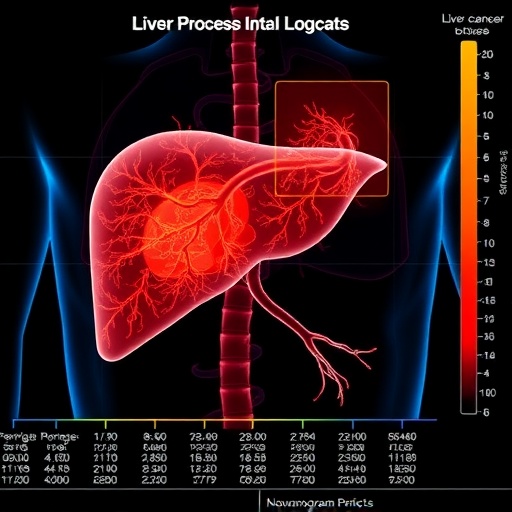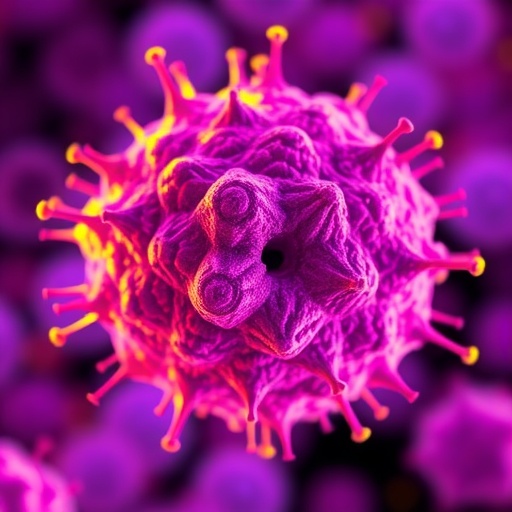
In the relentless battle against hepatocellular carcinoma (HCC), one of the deadliest forms of liver cancer, researchers have unveiled a groundbreaking predictive tool that promises to transform patient outcomes. A newly developed non-invasive nomogram, anchored by the novel biomarker Interleukin-41 (IL-41), offers clinicians an unprecedented ability to foresee tumor recurrence and mortality following curative liver resection. This innovation, detailed in a recent study published in BMC Cancer, leverages intricate molecular insights and advanced statistical modeling to address a longstanding challenge in oncology: accurately predicting HCC prognosis after surgery.
Hepatocellular carcinoma, accounting for the majority of primary liver cancers, is notorious for its high rates of postoperative recurrence and mortality, severely limiting long-term patient survival. Surgical resection with clear margins (R0 resection) remains the gold standard treatment for eligible patients. However, even after ostensibly successful surgery, a significant proportion of patients face relentless tumor relapse. Identifying which patients are at elevated risk remains a complex clinical puzzle, often complicated by heterogeneous tumor biology and diverse patient factors.
The investigative team, led by Mu, Z. and colleagues, conducted an ambitious study enrolling 224 HCC patients who had undergone R0 resection, aiming to decipher the molecular and pathological predictors that herald poor prognosis. By dividing the cohort into a training group of 149 patients and a validation group of 75, the researchers meticulously analyzed clinical data and tumor tissue features over time. Their approach combined cutting-edge molecular assays assessing IL-41 expression levels with rigorous statistical analyses, notably Cox proportional hazards regression, to isolate independent risk factors for both tumor recurrence and patient mortality.
Interleukin-41 emerged as a critical player in the malignant landscape of HCC. Known primarily for its immunomodulatory functions, elevated IL-41 expression within tumor tissues correlated strongly with increased risk of recurrence and death. Quantitatively, patients exhibiting high IL-41 expression faced more than double the hazard of recurrence (HR = 2.446), and alarmingly, a nearly fivefold increased risk of mortality (HR = 4.679), underscoring its potent biological impact.
Beyond IL-41, the study illuminated additional pathological contributors influencing patient outcomes. The presence of an intratumoral artery—a marker of aberrant neovascularization—was associated with a significantly higher risk of tumor recurrence (HR = 1.862). Meanwhile, microvascular invasion (MVI), specifically categorized into the MVI1 grade subgroup, further compounded recurrence risk (HR = 1.541). These vascular features reflect the tumor’s invasive potency and its capacity to disseminate malignant cells microscopically along vascular channels.
Tumor size and liver enzyme levels also factored prominently into mortality prediction. Tumors measuring 5 cm or larger conferred a substantial increase in death risk (HR = 3.745), highlighting the well-established relationship between tumor burden and prognosis. Additionally, elevated serum Aspartate Transaminase (AST) concentrations within the 45-90 U/L range were independently linked to heightened mortality risk (HR = 2.837), indicative of ongoing liver damage or dysfunction that may complicate postoperative recovery and therapeutic efficacy.
Crucially, these multifaceted variables were integrated into two multivariate nomograms—statistical models designed to individualize risk predictions. This tool translates complex clinical and molecular data into an accessible, user-friendly graphical format that clinicians can apply at the bedside or during multidisciplinary team discussions. Its predictive accuracy was validated internally, demonstrating robust performance in forecasting both recurrence and death trajectories beyond what conventional staging systems offer.
The advent of this nomogram represents a pivotal leap toward precision medicine in hepatocellular carcinoma care. Traditional prognostic models often rely heavily on clinical staging and histopathological features alone, which can overlook subtle but impactful molecular markers. Incorporating IL-41 into prognostic algorithms provides a biologically grounded, non-invasive biomarker that bridges tumor immunology with clinical outcome prediction.
Moreover, by stratifying patients according to individualized risk profiles, this nomogram can guide personalized surveillance strategies and therapeutic interventions. High-risk patients identified by elevated IL-41 and associated factors might benefit from intensified postoperative monitoring, adjunctive therapies, or enrollment in clinical trials exploring novel targeted agents or immunotherapies. Conversely, low-risk patients could potentially avoid unnecessary treatments and the attendant adverse effects, optimizing quality of life.
The study’s methodological rigor deserves emphasis. By utilizing a well-defined patient cohort with comprehensive follow-up, it minimized confounding variables and allowed for reliable statistical associations. The division into training and validation cohorts ensured that findings were not merely artifacts of overfitting but generalizable across different patient subsets. This approach strengthens confidence in the nomogram’s potential clinical utility.
From a biological perspective, IL-41’s prominence in HCC prognosis invites further investigation into its mechanistic role in tumor progression. As an interleukin, it may modulate the tumor microenvironment, influencing immune evasion, angiogenesis, or inflammatory cascades that fuel cancer cell proliferation and dissemination. Understanding these pathways could unlock new therapeutic targets and reposition IL-41 as both a prognostic marker and a candidate for intervention.
The integration of vascular characteristics—intratumoral artery presence and microvascular invasion—into the predictive model also resonates with emerging evidence underscoring the centrality of tumor vasculature in cancer aggressiveness. Targeting abnormal angiogenesis remains a cornerstone of anticancer strategies; thus, their association with recurrence affirms the need for combination approaches addressing both molecular signaling and vascular remodeling.
It is worth noting that liver function, as reflected by AST levels, remains an indispensable part of prognostic assessment. The liver’s unique regenerative capacity and metabolic functions profoundly influence cancer behavior and treatment tolerance. By encompassing liver enzyme measurements, the nomogram captures this vital aspect, reinforcing a holistic outlook on patient prognosis.
Despite the promising results, the authors recognize certain limitations. The study’s retrospective design and single-center data source indicate that external validation in diverse populations is essential before widespread clinical adoption. Additionally, longitudinal studies exploring whether interventions modulating IL-41 expression or vascular features can alter clinical outcomes would substantiate its role further.
In summary, this landmark research offers a sophisticated, evidence-based tool that refines our capacity to predict adverse outcomes in hepatocellular carcinoma after curative surgery. By harmonizing molecular biomarkers like Interleukin-41 with histopathological and biochemical parameters, the nomogram transcends traditional predictive models. It heralds a future where personalized prognostication empowers tailored therapeutic decision-making, ultimately aiming to improve survival rates and quality of life for patients battling this formidable cancer.
As oncology steadily embraces the convergence of molecular biology, computational analytics, and clinical practice, innovations like this nomogram exemplify the transformative potential of precision medicine. Researchers and clinicians alike anticipate that ongoing validation and refinement will cement its place in routine hepatocellular carcinoma management protocols, offering hope to thousands confronting a disease historically marked by unpredictability and poor prognosis.
Subject of Research: Hepatocellular carcinoma prognosis prediction using a novel biomarker
Article Title: A non-invasive nomogram for the prediction of poor prognosis of hepatocellular carcinoma based on the novel marker Interleukin-41
Article References: Mu, Z., Su, J., Yi, J. et al. A non-invasive nomogram for the prediction of poor prognosis of hepatocellular carcinoma based on the novel marker Interleukin-41. BMC Cancer 25, 941 (2025). https://doi.org/10.1186/s12885-025-14344-0
Image Credits: Scienmag.com
DOI: https://doi.org/10.1186/s12885-025-14344-0
Tags: advanced statistical modeling in oncologyclinical challenges in hepatocellular carcinoma managementhepatocellular carcinoma recurrence riskinnovative tools in cancer prognosisInterleukin-41 biomarker significanceliver cancer prognosis predictionmolecular predictors of liver cancernon-invasive nomogram for HCCpatient survival after liver resectionpostoperative mortality in HCC patientssurgical resection outcomes in liver cancerunderstanding tumor biology in HCC





